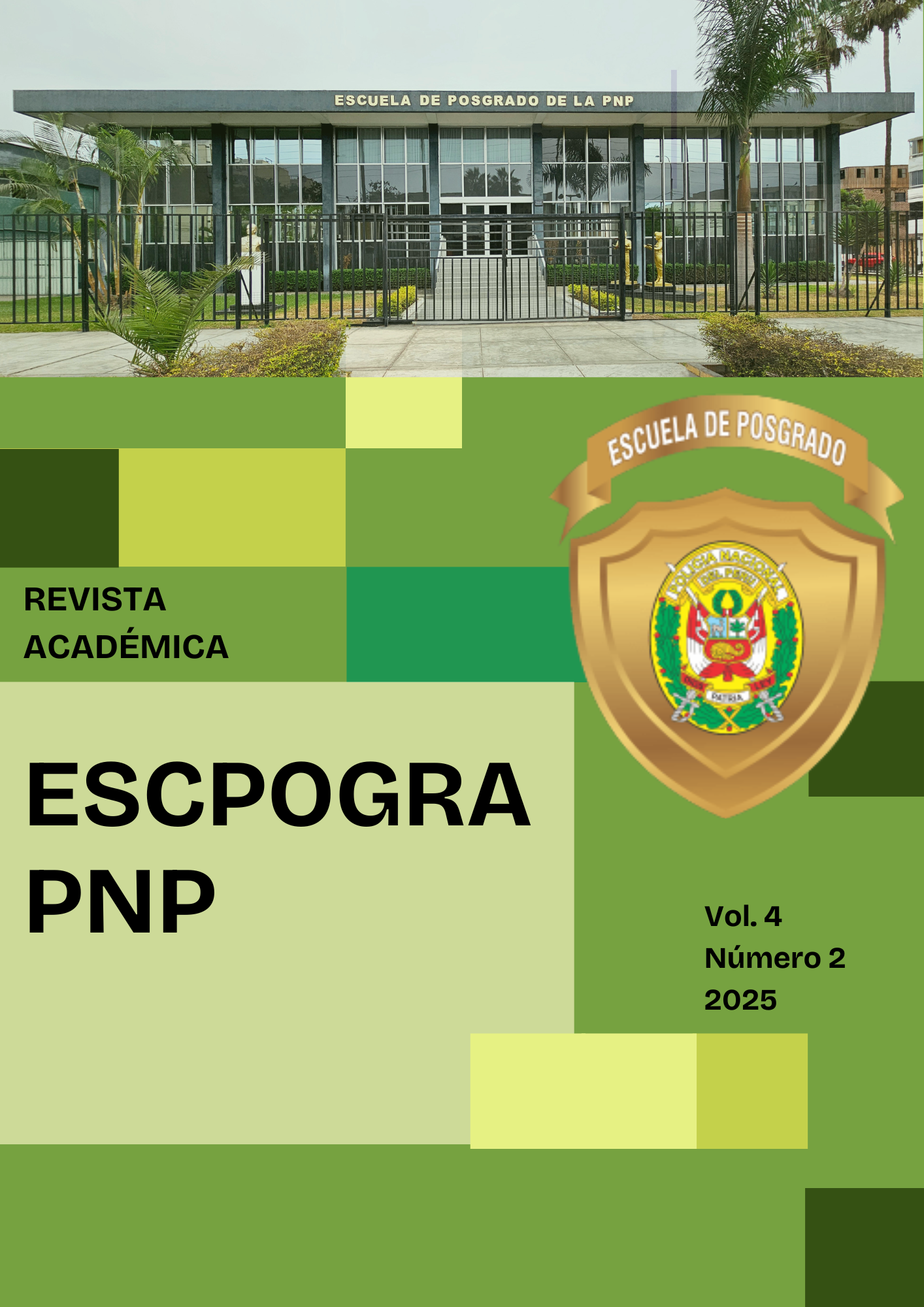Impacto de la Militarización de la Policía en la Seguridad Ciudadana: Una Revisión Sistemática
DOI:
https://doi.org/10.59956/escpograpnpv4n2.6Palabras clave:
Militarización, Policía, Seguridad Ciudadana, Derechos Humanos, Crimen Organizado, Violencia, Fuerzas de SeguridadResumen
El estudio analiza el impacto de la militarización de la policía en la seguridad ciudadana. Se examinan sus efectos operativos, sociales y de derechos humanos en distintos contextos internacionales. En cuanto a la metodología, se aplicó un enfoque cualitativo y descriptivo basado en el protocolo PRISMA. Se revisaron 52 estudios empíricos y teóricos publicados entre 2015 y 2024, seleccionados de bases de datos como Google Scholar y EBSCO. La muestra final incluyó 21 investigaciones tras aplicar criterios de inclusión, considerando estudios con evidencia directa sobre la relación entre militarización y seguridad ciudadana. Las fuentes de análisis abarcaron artículos sobre eficacia operativa, percepción pública y derechos humanos en América Latina, Estados Unidos y Europa. Los resultados muestran que, si bien la militarización fortalece la respuesta ante amenazas graves, también fomenta violencia policial, abuso de poder y erosión de la confianza pública. Se concluye que su implementación requiere regulación estricta y que modelos basados en cooperación comunitaria pueden ser más efectivos para garantizar la seguridad sin comprometer los derechos ciudadanos.
Descargas
Citas
Alexander, M. (2020). The new Jim Crow: Mass incarceration in the age of colorblindness (10th Anniversary Edition). The New Press.
Bayley, D. (2001). Democratizing the police abroad: What to do and how to do it. (Vol. 3). US Department of Justice, Office of Justice Programs, National Institute of Justice. https://www.ojp.gov/pdffiles1/nij/188742.pdf
Bejarano, M. (2021). Capacidad de respuesta en la seguridad pública del Comando de Educación y Doctrina del Ejército Peruano [Tesis de maestría, Universidad de San Martín de Porres]. https://hdl.handle.net/20.500.12727/10247
Bolduc, N. (2016). Global Insecurity: How Risk Theory Gave Rise to Global Police Militarization. Indiana Journal of Global Legal Studies, 23(1), 267–292. https://doi.org/10.2979/indjglolegstu.23.1.267
Bonanno, G. (2004). Loss, trauma, and human resilience: Have we underestimated the human capacity to thrive after extremely aversive events? American Psychologist, 59(1), 20-28. https://doi.org/10.1037/0003-066X.59.1.20
Burkhardt, B. C., y Baker, K. (2019). Agency Correlates of Police Militarization: The Case of MRAPs. Police Quarterly, 22(2), 161–191. https://doi.org/10.1177/1098611118800780
Cavalcanti, R. y Garmany, J. (2020). The politics of crime and militarised policing in brazil. International Journal for Crime, Justice and Social Democracy, 9(2), 102-118. https://doi.org/10.5204/ijcjsd.v9i2.1157
Chesterman, S. y Lehnardt, C. (2007). From mercenaries to market: The rise and regulation of private military companies. Oxford University Press. https://doi.org/10.1093/acprof:oso/9780199228485.001.0001
Dang, N. (2022). The implications of a militarized police force in the United States. Themis: Research Journal of Justice Studies and Forensic Science, 10(1), Article 2. https://doi.org/10.31979/THEMIS.2022.1002
Doherty, J. B. (2016). Us Vs. Them: The Militarization of American Law Enforcement and the Psychological Effect on Police Officers & Civilians. Southern California Interdisciplinary Law Journal, 25(2), 415–450. https://gould.usc.edu/why/students/orgs/ilj/assets/docs/25-2-Doherty.pdf
Flores-Macías, G., y Zarkin, J. (2024). The Consequences of Militarized Policing for Human Rights: Evidence from Mexico. Comparative Political Studies, 57(3), 387-418. https://doi.org/10.1177/00104140231168362
Ford, S. (2022). Restraining Police Use of Lethal Force and the Moral Problem of Militarization. Criminal Justice Ethics, 41(1), 1–20. https://doi.org/10.1080/0731129X.2022.2060014
Foucault, M. (1975). Surveiller et punir: Naissance de la prison. Gallimard.
Fox, B., Moule, R, y Parry, M. (2018). Categorically complex: A latent class analysis of public perceptions of police militarization. Journal of Criminal Justice, 58, 33–46. https://doi.org/10.1016/j.jcrimjus.2018.07.002
Friedman, B., y Jánszky, E. (2020). Policing’s Information Problem. Texas Law Review, 99(1), 1–71. https://texaslawreview.org/wp-content/uploads/2020/11/Friedman.Printer.pdf
Galtung, J. (1969). Violence, peace, and peace research. Journal of Peace Research, 6(3), 167-191. https://doi.org/10.1177/002234336900600301
Gan, N. (2020). Rule of law crisis, militarization of citizen security, and effects on human rights in Venezuela. European Review of Latin American & Caribbean Studies, 109, 67–86. https://doi.org/10.32992/erlacs.10577
Garland, D. (2001). The culture of control: Crime and social order in contemporary society. Oxford University Press.
Håndlykken-Luz, Å. (2020). “Racism is a perfect crime”: favela residents’ everyday experiences of police pacification, urban militarization, and prejudice in Rio de Janeiro. Ethnic & Racial Studies, 43(16), 348–367. https://doi.org/10.1080/01419870.2020.1800774
Kappeler, V. y Kraska, P. (2015). Normalising police militarisation, living in denial. Policing & Society, 25(3), 268-275. https://doi.org/10.1080/10439463.2013.864655
Lawson, E. (2019). TRENDS: Police Militarization and the Use of Lethal Force.Political Research Quarterly, 72(1), 177–189. http://www.jstor.org/stable/45276899
Lemieux, F. (2023). Militarization of Law Enforcement in America. Oxford Research Encyclopedia of Criminology. Retrieved. https://doi.org/10.1093/acrefore/9780190264079.013.62
Magaloni, B. y Rodriguez, L. (2020). Institutionalized Police Brutality: Torture, the Militarization of Security, and the Reform of Inquisitorial Criminal Justice in Mexico. American Political Science Review, 114(4), 1013–1034. https://doi.org/10.1017/S0003055420000520
Marquez, A. (2021). The rise of police militarization and impact on civilians. Themis: Research Journal of Justice Studies and Forensic Science, 9(1), Article 1. https://doi.org/10.31979/THEMIS.2021.0901
Martínez, M., y Medeiros, A. (2019). Militarización y multilateralización del policing: una mirada a Brasil y México. Les Études du CERI, (239-240), 81-92. https://doi.org/10.25647/etudesduceri.239-240.18.esp
Moule, R. Burruss, G., Parry, M. y Fox, B. (2019). Assessing the Direct and Indirect Effects of Legitimacy on Public Empowerment of Police: A Study of Public Support for Police Militarization in America. Law & Society Review, 53(1), 77–107. https://doi.org/10.1111/lasr.12379
Mummolo, J. (2018). Militarization fails to enhance police safety or reduce crime but may harm police reputation. Proceedings of the National Academy of Sciences of the United States of America, 115(37), 9181–9186. https://doi.org/10.1073/pnas.1805161115
Nateras, M. y Valencia, P. (2020). Riesgos de la militarización de la seguridad como respuesta a la violencia derivada del narcotráfico. El caso de Colombia y México. Espiral (Guadalajara), 27(78-79), 79-116. https://doi.org/10.32870/eees.v28i78-79.7069
Otieno, A. (2016). Human Rights–Based Policing to Foster Demilitarization. Peace Review, 28(2), 183–190. https://doi.org/10.1080/10402659.2016.1166749
Puluche, J. (2020). La militarización policial como política pública para la seguridad ciudadana, una revisión sistemática de las experiencias (Tesis de maestría, Universidad Cesar Vallejo). https://hdl.handle.net/20.500.12692/47291
Radil, S., Dezzani, R. y McAden, L. (2017). Geographies of U.S. Police Militarization and the Role of the 1033 Program. Professional Geographer, 69(2), 203–213. https://doi.org/10.1080/00330124.2016.1212666
Ramey, D. y Steidley, T. (2018). Policing through Subsidized Firepower: An Assessment of Rational Choice and Minority Threat Explanations of Police Participation in the 1033 Program*. Criminology, 56(4), 812–856. https://doi.org/10.1111/1745-9125.12193
Roziere, B., y Walby, K. (2018). The Expansion and Normalization of Police Militarization in Canada. Critical Criminology, 26(1), 29–48. https://doi.org/10.1007/s10612-017-9378-3
Saldaña, J., y Portocarrero, J. (2017). La violencia de las leyes: El uso de la fuerza y la criminalización de protestas socioambientales en el Perú. Derecho PUCP, (79), 311-352. https://doi.org/10.18800/derechopucp.201702.013
Seigel, M. (2019). Always Already Military: Police, Public Safety, and State Violence. American Quarterly, 71(2), 519–539. https://doi.org/10.1353/aq.2019.0041
Skogan, W. (2006). Advocate: The promise of community policing. In Police Innovation: Contrasting Perspectives. 27-43. Cambridge University Press. https://doi.org/10.1017/CBO9780511489334.002
Stavro, M., y Welch, R. (2024). Does Police Militarization Increase Repression? Journal of Conflict Resolution, 68(5), 964–992. https://doi.org/10.1177/00220027231187301
Sung, H., Capellan, J. y Barthuly, B. (2022). Trust in the police and the militarisation of law enforcement in Latin America. Policing & Society, 32(3), 311–340. https://doi.org/10.1080/10439463.2022.2037551
Tiscornia, L. (2024). Police reform in the aftermath of armed conflict: How militarization and accountability affect police violence. Journal of Peace Research, 61(3), 383–397. https://doi.org/10.1177/00223433221128846
Turner II, F., y Fox, B. H. (2019). Public servants or police soldiers? An analysis of opinions on the militarization of policing from police executives, law enforcement, and members of the 114th congress U.S. house of representatives. Police Practice and Research, 20(2), 122-138. https://doi.org/10.1080/15614263.2017.1371600
Tyler, T. (2006). Why people obey the law. Princeton University Press.
Weaver, V. M. (2018). More security may actually make us feel less secure. Proceedings of the National Academy of Sciences of the United States of America, 115(39), 9649–9651. https://doi.org/10.1073/pnas.1813014115
Descargas
Publicado
Cómo citar
Número
Sección
Licencia
Derechos de autor 2025 Revista Escpogra PNP

Esta obra está bajo una licencia internacional Creative Commons Atribución 4.0.























